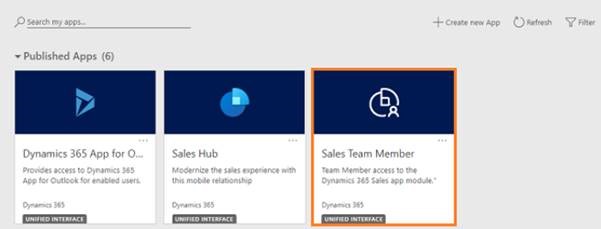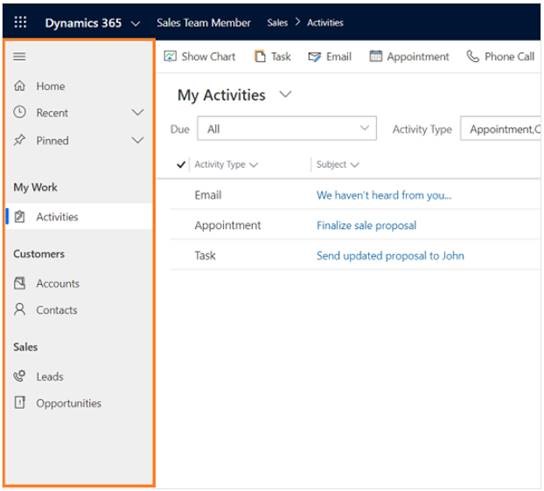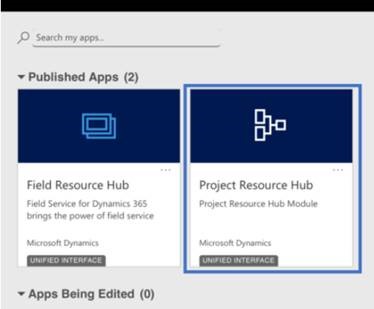Mar 17, 2020
Microsoft is now introducing a new product Dynamics 365 Project Operations in October 2020 as a replacement for Dynamics 365 Project Service Automation (PSA).
Microsoft Dynamics 365 Project Operations connects cross-functional teams to win more deals, accelerate delivery, empower employees, and maximize profitability. This application brings capabilities from our existing Dynamics 365 Project Service Automation, Microsoft Project for web, and project management accounting within Dynamics 365 Finance into a single offering. This Announcement provides an overview of the new Dynamics 365 Project Operations application, how we are working with Microsoft Project to address this market opportunity, and the change of service impact to Dynamics 365 customers.
What is changing?
Dynamics 365 Project Operations is the new application coming on October 1, 2020. Going forward, all roadmap investments for the PSA software market will be done through this application.
- Microsoft will discontinue sales of Dynamics 365 Project Service Automation to new customers on October 1, 2020.
- Early adopters can join the Dynamics 365 Project Operations public preview in June 2020, while Dynamics 365 Project Operations will become generally available on October 1, 2020.
- Eligible customers using Dynamics 365 Project Service Automation may continue to use it through October 1, 2022 if on a CSP contract, or October 1, 2024 for EA customers, or until the end of their most recent Dynamics 365 contract or renewal, whichever occurs first. Microsoft will offer a migration path to Dynamics 365 Project Operations.
Dynamics 365 Project Operations
Today’s project-based services businesses operate in a highly competitive market, where winning new contracts, accelerating project delivery, and increasing profit margins are significant challenges. Success in this highly competitive environment requires a solution that truly reimagines business operations across teams.
Dynamics 365 Project Operations will help project-intensive organizations run their entire services business – from prospects to payments, so they can:
- Win more deals and speed the sales cycle with fast, accurate quotes for projects, flexible pricing, and seamless transitions from estimate to execution
- Optimize resource utilization by aligning the right people with the right skills to the right projects—improving quality and helping you retain top performers.
- Speed project delivery with state-of-the-art, built-in project management that uses familiar, easy-to-use Microsoft Project capabilities.
- Simplify time and expense reporting with the ability to submit, approve, process, and reconcile time and expenses from anywhere—for faster reimbursement and client billing.
- Optimize project economics with project costing, budgeting, invoicing, revenue recognition, compliance, and visibility into key business health metrics such as gross margin and project profitability.
- Discover business insights powered by AI and increase agility with visibility across all your teams, data, and processes—for better, faster business decisions.
Dynamics 365 Project Operations is powerful on its own, but also expandable for our customers that require additional capabilities from Dynamics 365; including Sales, Finance, Marketing, Human Resources, Customer Service and more.
Impact to Dynamics 365 Project Service Automation (PSA) customer
Dynamics 365 Project Service Automation (PSA) currently includes project sales, resourcing and delivery capabilities. By adopting Dynamics 365 Project Operations, current PSA customers will get access to built-in capabilities from Microsoft Project for the web, as well as project financials. Current customers will get access to migration tools and will be grandfathered into Dynamics 365 Project Operations licensing. It’s important to note there will not be any immediate disruption of service, and we plan to work with customers to adopt Dynamics 365 Project Operations at their own pace. Customers evaluating PSA software solutions today should feel comfortable to continue their evaluation, purchase, and installation of our products, with knowledge and confidence of a strong product roadmap for Dynamics 365 Project Operations.
Impact to Dynamics 365 Finance customers using the project management and accounting capabilities
Dynamics 365 Finance currently includes a set of project management & accounting capabilities, such as Project Invoicing, Expense and Project Revenue Recognition, and more. These capabilities will transition from Dynamics 365 Finance and be maintained within Dynamics 365 Project Operations going forward. Current customers will get access to migration tools and will be grandfathered into Project Operations licensing.
Entitlements to project operations capabilities from within our Dynamics 365 Finance and Activity SKUs will no longer be included starting October 1, 2020. New customers purchasing these SKUs will not be entitled to project operations capabilities.
Project Operations application will improve the below unified operations:
- Project Sales with more contacts
- Project Managers accelerate project delivery
- Finance on-time and accurate project-based financials
- Team Members collaboration and simplified time and expenses
- Resourcing optimized resource utilization
- CxOx increased business agility
Mar 3, 2020
There is a new announcement from Microsoft concerning the Team Member Licensing, please feel free to send us your inquiry on the subject in case you need any clarifications.
Starting April 1st, 2020 team member license will lose access to their apps.
However, Microsoft has now revised its timeline whereby all existing customer instances impacted by this change, including users assigned the new Team Members SKU since 1 October 2018, will be granted an additional grace period until 30 June 2020.
New Change for Team Member Access:
- Dynamics 365 for Sales
- Dynamics 365 for Customer Service
- Dynamics 365 for Project Service Automation
What’s new?
The license enforcement will ensure that users with Team Member licenses can access only the designated app modules for Sales, Service, and Project Resource Hub.
License enforcement:
users with new Team Member licenses

Business value:
This licensing enforcement helps customers align with the Team Member license restrictions described in the Microsoft Dynamics 365 Licensing Guide.
Feature details:
For Team Member licenses purchased during or after October 2018, license-based access will restrict users to a set of designated app modules.
These users will no longer be able to access Customer Service Hub, Sales Hub, or custom app modules. The designated app modules are as follows:
- Customer Service Team Member
- Sales Team Member
- Project Resource Hub
During the early access phase, users with Team Member licenses will be able to use the designated app modules mentioned above alongside all existing apps. Once license enforcement is turned on (starting April 1, 2020), unentitled apps such as Customer Service Hub, Sales Hub, and custom apps will not be accessible. Customers are advised to test their Team Member scenarios and migrate customizations to the designated app modules as needed.
Before general availability, customers can enable enforcement within specific environments to proactively preview full enforcement (that is, the scenario where non-designated app modules are blocked based on license entitlement).
NOTE This feature is available in the Unified Interface only.
The new sales team member app released in the wave 1 is specifically designed for user having team member license.
At a high level, users with the Team Member license can perform the following tasks:
In the Sales Team Member app:
- Customer management: work with contacts or see accounts.
- Lead and opportunity management: see leads or opportunities linked with accounts or contacts or see other sales-related data.
- Add notes and activities, such as tasks.
In the customer service context, this app module enables the following limited set of use cases provided by the Team Member license for employee selfservice:
- Create cases.
- Read and update the cases that they created.
- Search and view knowledge articles.
Access the Team Member App:
Users with the Team Member license can go to home.dynamics.com. They’ll see the designated team member apps.

When users open the Sales Team Member app, in the site map, they’ll see the available entities.

With the Project Resource Hub app, you can enter time and expenses for the projects you’re working on the go. Stay on top of your time and expense entry to make sure:
- Your clients are billed properly
- You get credit for the work you’ve done
Select Project Resource Hub.

Jan 28, 2020
Microsoft made a new decision to retire dynamics 365 talent: Attract and Dynamics 365 Talent: Onboard apps on February 1, 2022, and are aligning future investments in this market with the solutions offered by LinkedIn.
Microsoft will continue investing in operational HR solutions with Dynamics 365 Human Resources releasing on February 3, 2020. Customers using core HR capabilities will be automatically transitioned to this new offering. Dynamics 365 Human Resources will help ensure the customers get the workforce insights needed to build data-driven employee experiences across compensation, benefits, leave and absence, compliance, payroll, performance feedback, training and certification, and self-service programs.
Here are some important details to help our customers with the transition:
- How long can customers use Attract and Onboard?
Service for the Attract and Onboard applications will end on February 1, 2022. Eligible customers can continue using Attract and Onboard until February 1, 2022 or the end of their most recent Dynamics 365 contract or renewal, whichever occurs first. Current customers will be able to renew their contract up until June 6, 2020.
Eligible customers are defined as either current customer who have purchased or renewed Dynamics 365 Talent, Dynamics 365 Unified Operations plan, or Dynamics 365 Plan 2 prior to February 3, 2020. or customers who have opted in via the defined process below. Customers who are not eligible by February 3, 2020 will be unable to access Attract or Onboard after February 3, 2020.
Opt-in process:
To allow time to opt-in, Dynamics 365 customers that are entitled to but are not currently using Attract or Onboard will have until February 3, 2020 to notify Microsoft that they intend to implement Attract and/or Onboard. You can opt- at any point between December 6, 2019 and February 3, 2020. If you are not currently using Attract and/or Onboard and want to opt-in to ensure service availability until February 1, 2022, you need to submit a support ticket.
- How long can Dynamics 365 Talent customers use core HR capabilities?
The core HR capabilities in Dynamics 365 Talent will be released as Dynamics 365 Human Resources on February 3, 2020. Eligible customers who are utilizing the core HR capabilities within Dynamics 365 Talent will have their service continued under Dynamics 365 Human Resources licensing with no disruption in service. No migration is required.
- Will Attract and Onboard be supported through retirement? Will there be additional feature development?
Microsoft will provide critical bug support until February 1, 2022. We will not be adding new capabilities into Attract or Onboard. Future investments will be made within Dynamics 365 Human Resources.
- Can we export the data, and will there be migration tooling available?
For Onboard customers, data export tools will be provided within the Onboard app to help export onboarding guides and templates.
- What is the deadline for exporting data out of Attract or Onboard?
Customers must export their data from Attract or Onboard by the end of their contract date or before February 1, 2022. Microsoft will provide data export tools from directly within Attract and Onboard.
- Will I have to keep paying for Attract and Onboard?
Yes, since customers can continue using these products over the next two years all contracts will remain in place until renewal or expiration. Dynamics 365 Talent customers will be automatically transitioned to Dynamics 365 Human Resources.
- Where do I learn more about LinkedIn Talent Hub?
Learn more about LinkedIn Talent Solutions and LinkedIn Talent Hub—a new Application Tracking System (ATS) that lets you source, manage, and hire – all in one place. Talent Hub gives hiring teams complete visibility into every stage of the hiring process and how candidates have engaged with your company – from candidate pipeline, interviews, feedback to extended offers. It also uses the actions, skills, and experience of the half a billion LinkedIn members to deliver insights about your candidates, the talent pool, and the market at every stage of the hiring process. This means you can get timely insights throughout your hiring process to help you make better talent decisions and gain an edge over the competition.
- Where do I learn more about other ISVs that provide Talent Acquisition solutions for Dynamics 365?
Find the right apps for your business and get Applicant Tracking and Onboarding solutions tailored to your industry that work with Dynamics 365 Human Resources on Microsoft AppSource.
- What are my next steps?
If you are only using the core HR capabilities within Dynamics 365 Talent, you can continue business as usual without any disruption. If you are using Attract or Onboard, we recommend that you reach out to your account team or partner to get more information and build a plan to transition off of the service by February 1, 2022, or the contract end date, whichever comes first.
Jan 17, 2017
 Microsoft will not be announcing any price changes in January 2017 for SPLA licenses. However, Microsoft Dynamics® 365 released in SPLA on February 1, 2016, will replace the current Dynamics CRM SKUs. Microsoft Dynamics 365 is the next generation of intelligent business applications that enable organizations to grow, evolve, and transform. These applications provide CRM capabilities to help engage customers, empower employees, and reinvent products and business models. Microsoft Dynamics 365 helps customers to accelerate their digital transformation to meet the changing needs of their customers and capture the new business opportunities of tomorrow.
Microsoft will not be announcing any price changes in January 2017 for SPLA licenses. However, Microsoft Dynamics® 365 released in SPLA on February 1, 2016, will replace the current Dynamics CRM SKUs. Microsoft Dynamics 365 is the next generation of intelligent business applications that enable organizations to grow, evolve, and transform. These applications provide CRM capabilities to help engage customers, empower employees, and reinvent products and business models. Microsoft Dynamics 365 helps customers to accelerate their digital transformation to meet the changing needs of their customers and capture the new business opportunities of tomorrow.
Changes:
- Dynamics 365 will include Sales, Customer Services and Team Members SALs.
- The new SKUs/SALs will appear on the February 1, 2017 SPLA price list and the February SPUR
- Microsoft Dynamics® 365 released in SPLA on February 1, 2016, will replace the current Dynamics CRM SKUs
The following SKUs will be removed from SPLA in February 2017:
| Part Number |
Description |
| QHH-00028 |
DynCRMSrvcPrvdr ALNG LicSAPk MVL SAL |
| QHH-00089 |
DynCRMSrvcPrvdr ALNG LicSAPk MVL SAL Bsc |
| QHH-00090 |
DynCRMSrvcPrvdr ALNG LicSAPk MVL SAL Essntls |
The following SKUs will be added in SPLA in February 2017:
| Part Number |
Description |
| EMJ-00429 |
Dyn365ForTeamMembers ALNG LicSAPk MVL SAL |
| EMT-00565 |
Dyn365ForCustmrSrvc ALNG LicSAPk MVL SAL |
| ENJ-00705 |
Dyn365ForSales ALNG LicSAPk MVL SAL |
The following table includes the mapping of the old Dynamics Sku’s (AX & CRM) to the new Dynamics 365 Sku’s:
| Existing User License |
New User License |
| Pro User SAL |
Sales User SAL |
| Pro User SAL |
Customer Service User SAL |
| Basic User SAL |
Sales User SAL |
| Basic User SAL |
Customer Service User SAL |
| Essential User SAL |
Team Members User SAL |
Jun 22, 2016
 Nowadays companies want to have an ERP solution but want to keep their data on their servers. However, they don’t have the expertise for managing these servers and they don’t want to pay a big investment upfront.
Nowadays companies want to have an ERP solution but want to keep their data on their servers. However, they don’t have the expertise for managing these servers and they don’t want to pay a big investment upfront.
After signing the Microsoft SPLA, partner can provide a full Managed Services solution to the end customer while adding his cost to the type of license and differentiate the price based on license type and edition. Customer will have therefore a simple pay-as-you go monthly payment with no upfront cost.
What are the benefits for partner and end customer?
Benefits for Customer:
- Customer doesn’t have big upfront costs
- Customer will have a pay as you go payment method
- Customer always has access to the most current product versions
- Partner can deliver the solution customized based on customer’s requirements
Benefits for Partner:
- Partner now has an option B to capture all lost opportunities for customers who can’t afford big investments
- Partner can add to his offering his support and margin in order to increase his revenue
- No upfront commitment for partner
In addition to that, BPS Team is available round the clock to help assist you in:
- Advising in product selection, licensing, go to market, hosting projects bidding & platforms (Dynamics as a Service)
- Pre-sales advising: Assisting with all licensing questions and queries (by a group of licensing experts)
- Pricing for your end-customer projects based on a design sent per project
- Start now by joining the partner program
Aug 9, 2014
Microsoft Dynamics CRM versions have a requirements in order to operate correctly. Microsoft Dynamics CRM technology would surely need a Microsoft SQL database to store the entries. Below are the complete requirements to use Microsoft Dynamics CRM include:
- Microsoft Windows Server
- A Microsoft Windows Server Active Directory infrastructure
- An Internet Information Services (IIS) website
- Microsoft SQL Server
- Microsoft SQL Server Reporting Services
- Microsoft Exchange Server or access to a POP3-compliant email server (optional)
- Windows operating system when you use CRM for Outlook. Apple Mac, when running Apple Safari, supported tablet, or mobile device.
- Supported web browser, such as later versions of Internet Explorer or the latest versions of Apple Safari, Google Chrome and Mozilla Firefox.
- Supported web browser, such as later versions of Internet Explorer or the latest versions of Apple Safari, Google Chrome and Mozilla Firefox.
SharePoint Requirements:
- Microsoft SQL Server
- Windows Server 2012 Standard or Datacenter














